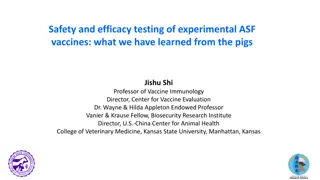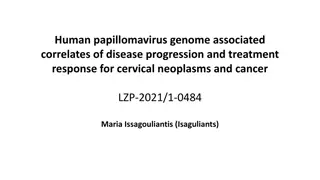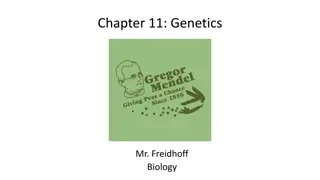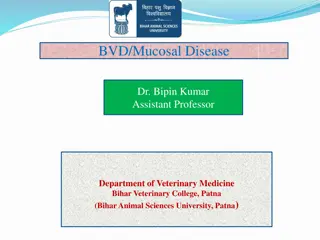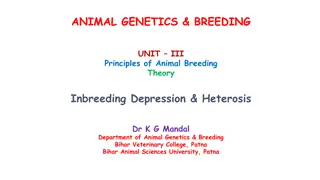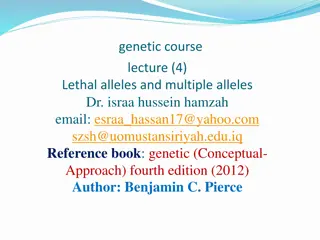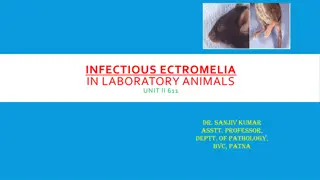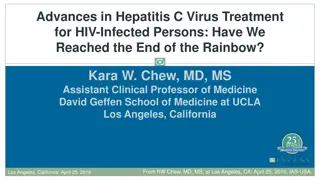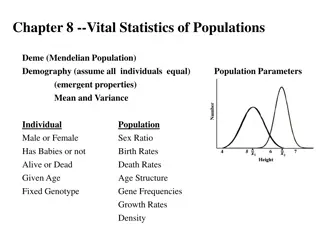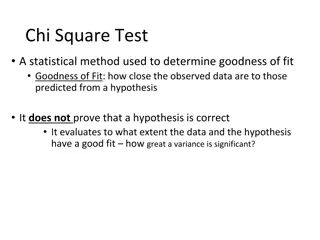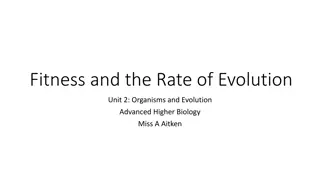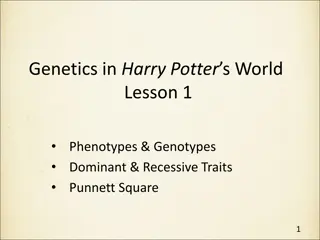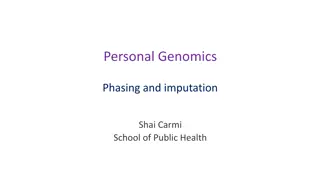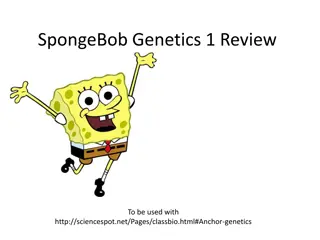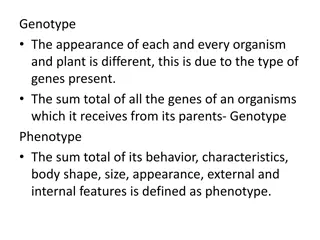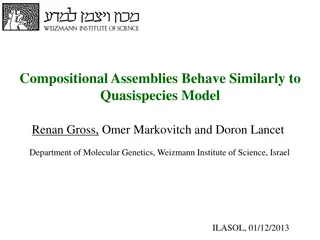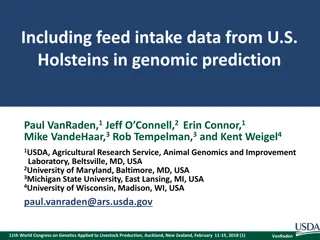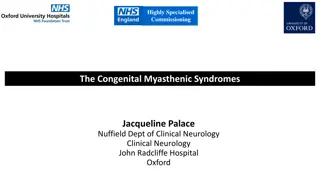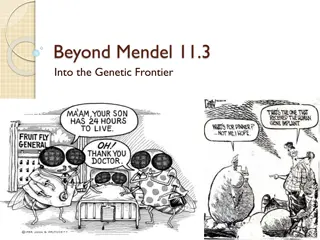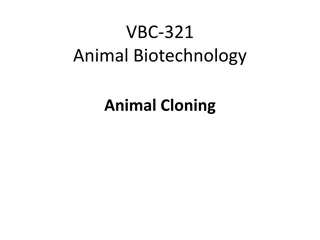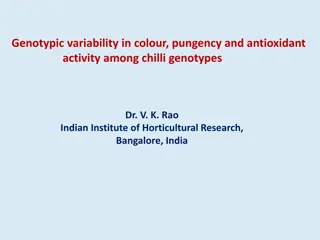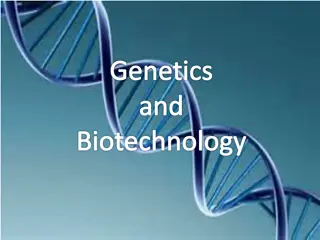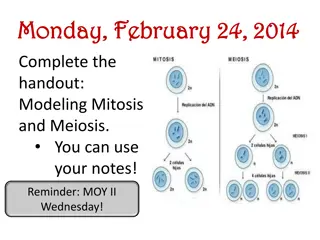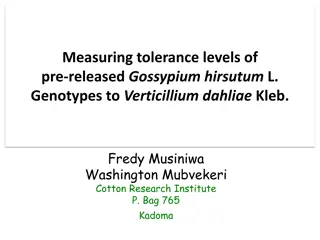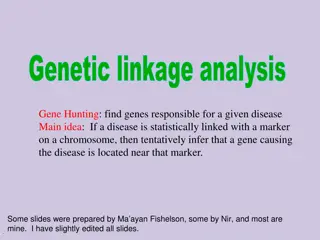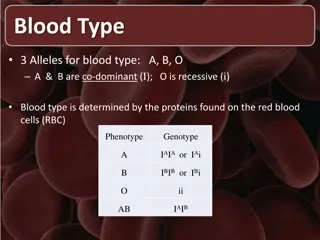Insights on Experimental ASF Vaccines in Pig Studies
The research conducted by Prof. Jishu Shi and his team at Kansas State University delves into the safety and efficacy testing of experimental African Swine Fever (ASF) vaccines using pigs as the model. Various vaccines, including DNA vaccines and live attenuated viruses, were tested against differen
4 views • 13 slides
Investigating Human Papillomavirus Genomes in Cervical Neoplasms
This project focuses on studying the Human Papillomavirus (HPV) genome's association with disease progression and treatment response in cervical neoplasms and cancer. The research aims to genotype high-risk HPVs in healthy and diseased cervix, identify prevalent genotypes, detect genotype drift, cha
1 views • 13 slides
Understanding Genetics: A Comprehensive Overview
Genetics is the study of genes, heredity, and variation in living organisms. This chapter explores key concepts such as phenotypes, genes, alleles, genotypes, and the laws of dominance. Through Punnett squares, the inheritance patterns of traits can be predicted, shedding light on how traits are pas
1 views • 35 slides
Understanding Incomplete and Co-dominance in Genetics
Phenotypes and genotypes play crucial roles in understanding incomplete dominance and co-dominance. In incomplete dominance, alleles blend to produce a new phenotype, while in co-dominance, both alleles are expressed equally. Examples and problems illustrate these concepts further, aiding in genetic
0 views • 12 slides
Principles of Animal Breeding: Selection and its Basis
Selection in animal breeding involves choosing the best individuals to improve specific traits. Criteria for selection include individual merit, competitive exams, and interviews. Selection of farm animals focuses on non-random reproduction of genotypes. Types of selection include natural and artifi
1 views • 40 slides
Understanding Multiple Alleles in Genetics
Explore the concept of multiple alleles in genetics through examples like pea color inheritance and human blood types. Learn how multiple alleles create various phenotypes and genotypes, illustrating concepts of dominance, recessiveness, and co-dominance in genetic inheritance.
0 views • 15 slides
Understanding Modes of Inheritance According to Mendel's Laws
Explore the fundamentals of genetics by assessing Mendel's laws of inheritance, understanding Mendelian inheritance bases, and defining various patterns of single-gene inheritance using family pedigrees and Punnett squares. Dive into the fascinating world of genotypes, Punnett squares, and laws of d
0 views • 29 slides
Unlocking the Clinical Significance of Alloimmunization in Transfusion Medicine
Alloimmunization, a critical side effect of transfusion, has been a challenge in matching phenotypes and genotypes globally. The detection of clinically significant antibodies requires a delicate balance between sensitivity and specificity, considering various controllable and uncontrollable variabl
0 views • 20 slides
Understanding Bovine Virus Diarrhea and Mucosal Disease in Cattle
Bovine Virus Diarrhea (BVD) and Mucosal Disease (MD) are two clinically distinct yet interconnected syndromes in cattle caused by Pestivirus. While originally thought to be separate, they share a common viral etiology. BVD can lead to persistent infections, while MD is sporadic, progressive, and fat
0 views • 14 slides
Understanding Sickle Cell Disease: Core Concepts for Healthcare Professionals
Sickle Cell Disease (SCD) is a genetic disorder primarily affecting individuals of African descent but also found in other ethnic groups. The most severe form is sickle cell anemia (SS), presenting with life-threatening complications. This article explores the epidemiology, genotypes, and changes in
0 views • 18 slides
Understanding Inbreeding Depression and Heterosis in Animal Genetics
Inbreeding depression is a decrease in the mean phenotypic value of traits related to fitness and physiological efficiency due to inbreeding. It involves a reduction in heterozygosity within a population, leading to an increase in homozygosity. The degree of inbreeding is quantified using the inbree
0 views • 24 slides
Understanding Lethal Alleles and Multiple Alleles in Genetics
Lethal alleles are mutant genes that result in the death of individuals carrying them, either in prenatal or postnatal stages. Both dominant and recessive lethal alleles have distinct effects on the population genetics. Examples in plants like snapdragons and maize demonstrate how lethal alleles imp
0 views • 18 slides
Understanding Infectious Ectromelia in Laboratory Animals
Infectious Ectromelia, also known as Mousepox, is a viral disease causing high mortality in adult mice and limb amputation in surviving cases. It is characterized by skin lesions, rash, and generalized fatal disease. Various strains of the virus exist, with transmission occurring through abrasions o
0 views • 16 slides
Advances in Hepatitis C Treatment for HIV-Infected Patients: A Comprehensive Overview
Explore the latest advancements in the treatment of Hepatitis C virus (HCV) in HIV-infected individuals through a detailed presentation by Dr. Kara W. Chew. Learn about the initial evaluation for HCV, treatment options for different genotypes, management of advanced fibrosis, recommended approaches
0 views • 9 slides
Understanding Vital Population Statistics and Demography
Exploring vital statistics of populations with a focus on Mendelian populations and demography, analyzing factors like sex ratio, birth rates, death rates, age structure, gene frequencies, growth rates, and population density. The content delves into emergent properties, mean and variance population
0 views • 9 slides
Exploring Robustness and Developmental Systems: A Workshop Overview
Delve into the intricate world of developmental systems and robustness with insights from Paul E. Griffiths. Discover the evolution of developmental processes, the significance of epigenetics, and the interplay between genotypes and phenotypes. Gain a deeper understanding of epigenetic inheritance a
0 views • 17 slides
Understanding Chi-Square Test for Goodness of Fit
Chi-square test is a statistical method used to assess how well observed data match the predicted values from a hypothesis. It does not confirm the hypothesis but measures the extent of fit between data and the hypothesis. This test is crucial for determining the significance of differences between
0 views • 10 slides
Understanding Punnett Squares for Predicting Offspring Genotypes
Punnett squares are a visual tool used to predict the possible genotypes and phenotypes of offspring based on the parent's genetic makeup. By following simple steps and understanding dominant and recessive traits, you can calculate the likelihood of different genetic outcomes for traits like hair co
0 views • 7 slides
Understanding Genetics: Chromosomes, Genes, and Inheritance
Genetics encompasses the study of chromosomes, genes, and inheritance patterns. Chromosomes are bar-like structures carrying DNA, with homologous pairs determining traits. Autosomes and sex chromosomes play roles in genetic makeup. Genes are hereditary units determining individual traits, with allel
0 views • 20 slides
Understanding Fitness and Evolution Rates in Organisms
Fitness in organisms is crucial for their survival in a given environment. Absolute fitness measures genotype frequencies between generations, while relative fitness compares genotypes to the most successful one. Factors like selection pressure can increase the rate of evolution by promoting benefic
0 views • 14 slides
Understanding Genotype and Phenotype in Hereditary Traits
Exploring simple heredity through predicting and modeling phenotypes of Crazy Creatures, students are tasked with contrasting genotype and phenotype. The Crazy Traits lab data table is essential for recording alleles and genotypes, aiding in determining phenotypes for 14 different traits. By complet
0 views • 4 slides
Understanding Genetics in Harry Potter's World
Explore the inherited genetic traits in the Harry Potter series, including phenotypes and genotypes of characters like the Weasleys, Draco Malfoy, and Harry Potter. Delve into observable traits like freckles, hair color, eye color, and height, and learn how to apply genetics concepts through example
0 views • 29 slides
Understanding Phasing in Personal Genomics
Phasing in personal genomics involves resolving haplotypes from diploid genotypes to identify associations with diseases, compound heterozygosity, shared haplotypes, and ancestral origins. It helps in detecting relatives, historical recombination events, and haplotypes under selection. Different typ
0 views • 53 slides
Genetics Practice: Dog and Flower Color Inheritance
Explore genetics through practice questions on dog coat color inheritance and flower color inheritance. Answer correctly to progress and learn more about genotypes and phenotypes.
0 views • 43 slides
SpongeBob Genetics Review Questions & Phenotype Determination
Explore genetics concepts using SpongeBob-themed questions to differentiate between heterozygous and homozygous genotypes, identify purebred and hybrid genotypes, and determine phenotypes based on dominant and recessive traits like body color and shape.
0 views • 17 slides
Understanding Genotype and Phenotype: The Genetic Basis of Organism Variation
Genotype determines the genetic makeup of an organism, while phenotype encompasses its observable traits. Johannsen's theory states that phenotype is a result of genotype, which remains constant throughout life. The concept of phenocopy refers to mimicking another phenotype without altering the geno
0 views • 15 slides
Guava Breeding: Strategies and Objectives for Improved Cultivation
Guava, a hardy fruit grown in various states in India, has significant breeding objectives such as developing seedless varieties, enhancing pectin content, achieving uniform ripening, and improving resistance to pests. Various genotypes and floral biology aspects play a role in the breeding process.
0 views • 38 slides
Understanding Compositional Assemblies and Quasispecies Model
Compositional assemblies exhibit behavior similar to the quasispecies model, as explored by Renan Gross, Omer Markovitch, and Doron Lancet at the Weizmann Institute of Science. This model provides insight into population dynamics and the replication processes of genotypes within environments, sheddi
0 views • 35 slides
Overview of Bovine Viral Diarrhea Virus (BVDV)
Bovine Viral Diarrhea Virus (BVDV) is an RNA virus belonging to the Pestivirus genus in the Flaviviridae family. It is classified into BVDV-1 and BVDV-2 genotypes with distinct biotypes. BVDV is a significant infectious disease in the livestock industry worldwide, with high prevalence and clinical c
0 views • 14 slides
Genomic Prediction of Feed Intake in U.S. Holsteins
This study discusses the inclusion of feed intake data from U.S. Holsteins in genomic prediction, focusing on residual feed intake (RFI) as a new trait. The research involves data from research herds and genotypes of cows, with genetic evaluation models and genomic evaluation for predicting feed int
0 views • 17 slides
Specialised Commissioning for Congenital Myasthenic Syndromes - Overview by Professor Jacqueline Palace
Delve into the highly specialised commissioning of Congenital Myasthenic Syndromes by Professor Jacqueline Palace from the Nuffield Department of Clinical Neurology at John Radcliffe Hospital, Oxford. Explore key messages, learning objectives, and disclosures related to diagnosing, differentiating,
0 views • 4 slides
Understanding Genetic Inheritance Patterns and Human Blood Types
Explore how genes can be inherited based on patterns such as Mendel's dominance, incomplete dominance, co-dominance, and multiple alleles. Dive into the complexities of human blood types controlled by one gene with three alleles - A, B, and O, resulting in four phenotypes and six genotypes. Learn ho
0 views • 19 slides
Applications of Transgenic Animals in Biotechnology and Cloning
Cloning in animals offers the advantage of indefinite duplication of elite genotypes without the genetic risks of meiosis. Transgenic animals, genetically modified to carry foreign genes, play a crucial role in genetic research and the development of livestock with desired traits. Methods like DNA m
0 views • 13 slides
Genotypic Variability in Chilli: Colour, Pungency, and Antioxidant Activity
This study explores the genotypic variability in colour, pungency, and antioxidant activity among different chilli genotypes, highlighting the importance of chillies as a major spice crop in India and various other countries. The research aims to analyze the extent of variability in key parameters s
0 views • 31 slides
Exploring Genetics and Biotechnology Concepts
This educational content delves into various genetics and biotechnology concepts, including genotypes, DNA segments, heredity, flower color inheritance, genetic crosses, and biotechnology processes. It clarifies terms like homozygous, heterozygous, dominant alleles, DNA components, and parental trai
0 views • 31 slides
Understanding Genetics: Mendel's Experiments and Inheritance Patterns
Delve into the world of genetics through Mendel's groundbreaking experiments with pea plants, exploring traits inheritance, Punnett squares, dominant and recessive alleles, incomplete dominance, and co-dominance. Gain insights into how traits are passed from parents to offspring and predict offsprin
0 views • 9 slides
Tolerance Levels of Gossypium hirsutum L. Genotypes to Verticillium dahliae Kleb.
The study aims to measure the tolerance levels of pre-released Gossypium hirsutum L. genotypes to Verticillium dahliae Kleb, a soil-borne fungus causing Verticillium wilt in cotton. The research, conducted at the Cotton Research Institute, focuses on determining tolerance levels of new cotton genoty
0 views • 18 slides
Comprehensive Guide to Identifying Carbapenem-Resistant Isolates Without Common Acquired Carbapenem Resistance Genes
Utilize the Isolates Browser on NCBI Pathogen Detection platform to search for carbapenem-resistant isolates without common acquired resistance genes. Follow steps such as using AST phenotypes and AMR genotypes, cross-browser selection, and filters to isolate relevant results. Detailed instructions
0 views • 6 slides
Understanding Gene Hunting and Disease Genes in Human Genetics
Gene hunting involves finding genes responsible for diseases by statistically linking them with markers on chromosomes. This process relies on the logical structure of chromosomes, genotypes versus phenotypes, recombination phenomena, and specific loci like the ABO locus on Chromosome 9. By analyzin
0 views • 18 slides
Understanding Blood Types: A Comprehensive Overview
Blood types are determined by specific proteins on red blood cells, with antigens playing a crucial role in compatibility. This detailed guide covers the three main alleles for blood types (A, B, O), their phenotypes, genotypes, and antigen characteristics. Additionally, it explains the implications
0 views • 7 slides
